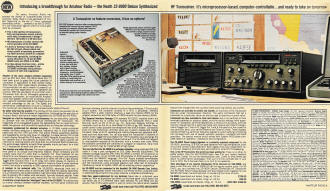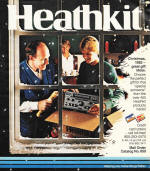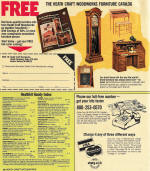|
Prior to the availability
of affordable synthesized transceivers under microprocessor control, Ham radio operators
needed to tune a continuously variable local oscillator (internal or external) or
have a selection of crystals for specific frequencies. Even by 1982 microprocessors
were relatively expensive, so equipment incorporating them was also pricey. Heathkit's
model SS-9000 claimed to be designed by amateurs for amateurs, and was "so feature-conscious,
it has no options." That's right, anything and everything that could be imagined
was included in the base model; there we no upgrades. It used a high accuracy and
stability internal 10 MHz reference oscillator for the PLL synthesizer. Also
incorporated was an RS-232 serial port for control via computer (up to 9600 baud!),
such as the Heathkit/Zenith personal computer (the
IBM PC had
hit the market in the prior year, and the the Radio Shack
TRS-80 and
Apple II had been around
since 1977). The SS-9000 was solid state throughout (likely where the "SS" prefix
originated). The unit was evidently so sophisticated that it was only offered in
a fully assembled and tested form, which was fairly rare for Heathkit. By 1982,
they were probably having products like this assembled overseas. This info
was scanned from my hard copy of the Heathkit 1982 Christmas catalog.
Heathkit Christmas 1982 Catalog
 Heath SS-9000
Deluxe Synthesized HF Transceiver Heath SS-9000
Deluxe Synthesized HF Transceiver
Introducing a breakthrough for Amateur Radio - the Heath SS-9000 Deluxe Synthesized
HF Transceiver. It's microprocessor-based, computer-controllable ... and ready to
take on tomorrow
For years, Amateur Radio has awaited the advent of computer-aided communications.
Today, there's a new generation of contact beginning as the era of 'micro' enhanced
ham shacks arrives ... ushered in by the SS-9000. It is one Transceiver against
which all future gear must be compared.
• This is the Cadillac of transceivers: Fully microprocessor-based, entirely
solid-state, broad banded in design delivers 100 watts to a 50 ohm load
• Microprocessor circuitry controls the entire operation of the SS-9000
• A built-in Terminal Interface with an RS-232 I/O port allows instant and
direct control of operating parameters via ASCII terminal, modem or computer
• Nine-band operability, including the newly-allocated 10, 18 and 24 MHz
WARC bands and WWV at 15 MHz
• An idea whose time has come - unlike anything that has preceded it, the
SS-9000 challenges every previous resource of skill and imagination
Readers of the many amateur-oriented magazines such as QST, ham radio, CQ, World
Radio and 73 have been quick to grasp the future potential of computers in application
to their worldly hobby. More than any other single station accessory, the microcomputer
can add a wealth of powerful capability and fast organization to an operator's air
practice. With the assistance of a terminal, and a Transceiver that can be thoroughly
governed by keyboard commands, an experienced Amateur could have greater control
over all phases of contact, reams of important data at his fingertips and enviable
advantage on the air. The speed and performance characteristics of such a combination
would put new meaning in the overused words 'state-of-the-art.'
No better time than the present: The promise of this vision has evolved into
an American design that surpasses all expectation. Anticipating the evolution of
Amateur Radio, the hams at Heath engineered the SS-9000 and PS-9000.
Designed as a tool for development and discovery: No one else offers capability
to compare with the SS-9000 Deluxe Synthesized HF Transceiver. The magnitude of
its manageability gives the pacesetting ham an opportunity to break new ground,
and promote the applications of computer technology.
Completely synthesized for absolute accuracy: A 10 MHz crystal-controlled master
oscillator produces a reference frequency that is clock-divided to phase-lock the
IFO, HFO and BFO. This action affords superlative stability and repeatability during
long hours of operation. A Single precise VFO is tied to each display through the
256 bytes of CMOS Random Access Memory. For the operator who is accustomed to several
nets, DX hot spots, favorite call channels or listening points and more than one
scheduled band rendezvous, this extra storage capacity accepts three separate inputs
per band, for a total of 27 frequencies to recall and work at will.
Two displays are better than one: The most outstanding feature of the SS-9000
front panel is its unique dual frequency readout. Smart contesters and DX hunters
know that it's more than a cosmetic frill. Dual readouts let you transmit on one
frequency and receive on another, or maintain one frequency while scanning for a
better one. Transceiver on either the left or right display. Toggle their function
from T to R. Copy from either display to memory, or exchange either with the frequency
stored in memory. Place it under terminal control, and enjoy a versatility in QSO
capture that shatters all precedent.
A receiver to be reckoned with: The SS-9000's advanced front end is highlighted
by twelve poles of distributed SSB filters for optimal selectivity, 0.3 μV sensitivity
and a phenomenally high third order intercept point. Audio gain is typically 30
or better, with one result: Typically fantastic results! Three switchable filters
provide extra selectivity for the critical CW operator. A controller circuit forms
the "intelligent' heart of the SS-9000. This device acts as a serial interface between
external requests, via front panel controls and terminal interface, and the internal
circuits on the synthesizer, T/R and audio circuit boards. The controller consists
of a CPU, a peripheral interface adapter (PIA), a static memory interface, a read
only memory (ROM, for the program sequence) and 256 bytes of CMOS random access
memory (RAM).
The Terminal Interface Package (EIA standard RS-232C) installed within the SS-9000
allows you to control and monitor the Transceiver from a video terminal (such as
the H-19 on pg. 71), hard-copy teletype terminal, or computer (such as the All-In-One
Model H/Z-89 on pg. 68). Remote Transceiver control is also possible over telephone
lines with a modem. Commands built-in to the Transceiver controller allow you to
select, display and change the band, mode, up to 27 operating and memory frequencies,
passband shift, band scan and baud rates. You can also place the Transceiver in
transmit or receive mode, toggle the dual readout for T/R/Tr operation plus exchange
the one memory and two displayed frequencies at will. The SS-9000 will respond to
unacceptable requests at the terminal, with a numeric error code. When the available
commands are combined in a program or sequence, many more useful functions may be
implemented at high speed.
You can interface the SS-9000 to a personal computer using a standard RS-232
cable if it has a port configured as DTE (Data Terminal Equipment). The software
package supplied with every SS-9000 is written for connection to port 3300 (octal),
on an H/Z-89 with 48 kilobytes of RAM operating under HDOS and the MBASIC language.
This 5 1/4" floppy diskette demonstrates only one of the many ways of providing
communication between a computer and the Transceiver, using animated graphics and
video text to thoroughly introduce an owner to System 9000 and its amazing control
capabilities.
An SS-9000 can be connected to the Heathkit SA-1480 Remote Coax Switch. When
changing bands (either manually or via remote control, using the built-in Motorized
Band Switch) the proper antenna is selected automatically.
Data flow speed-customized for any terminal: Baud rate is initialized upon power-up.
With an 8-position dip switch on the front panel circuit board, you can select any
of 15 different baud rates between 50 and 9600 bits per second. Half of this same
switch is used to control the rate at which readout frequencies change when the
up/down band-scanning buttons are pushed.
A Transceiver so feature-conscious, it has no options!
RS-232 Terminal Interface offers communication between the Transceiver and external
ASCII terminal or computer. Motorized Computer Bandswitch rotates the band selector
to desired setting under remote control.
Extended memory allows storage of three frequencies per band, and memory preserved
up to one year with battery backup. Unique dual digital display offers new versatility
in frequency - handling speed and agility. Four T and R indicator LEDs identify
which display is controlling the transmitter and receiver, or if either display
is to transceive.
Front panel and main circuit boards are hinged for easy access. Main tuning knob
has optically-encoded shaft for smooth, linkage-free control and zero backlash.
Diode-balanced mixers and dual-gate MOSFETs provide higher sensitivity and dynamic
range. Superior over-current, thermal and high VSWR protection means you can operate
worry-free.
Durable, die-cast zinc front panel gives precise signal control, and includes:
selectable VOX with variable delay or PTT operation. Receiver Incremental Tuning.
An adjustable RF speech processor. Plus and minus passband shift. Impulse-type noise
blanker. RTTY capability. Fast and Slow AGC with OFF position. Standard fitters
tor CW-wide and CW-narrow selectivity. Pushbutton up and down band scanning in 16
selectable rates with 100 Hz resolution. A four-function meter which indicates received
signal strength, ALC, relative power and compression level.
Commands are provided to control and monitor all functions of the Transceiver
that are under microprocessor direction. The same commands that set a parameter
to a particular value can also be used to examine a current value.
Commands are also available to Lock and release one or all switches to their
terminal-controlled or physical states, print the switch settings (with appropriate
"L" indication), print the frequencies in memory for all bands, print the memory
frequencies for a particular band with receive and transmit assignments flagged
by T and/or R, toggle the T and R indicators for the current or any particular band,
plus set the Receive and Transmit mode. These displays may be limited to a particular
frequency register or switch setting by following the command with one of several
symbols, operators, constants and band specifiers. The special manual which arrives
with System 9000 gives complete details on operation, installation and configuration.
The PS-9000 Power Supply/Speaker is a perfectly matched component for the SS-9000,
providing 13.8 VDC for base operation with high temperature, short circuit and current
surge protection. Each digital clock has independent 12- or 24-hour capability and
fast/slow set buttons for local/UTC timekeeping.
This is the HF Transceiver the world has been waiting for. There is no other,
no better system than the SS/PS-9000 team. See it at your nearby Heathkit Electronic
Center. Tryout the demonstration disk. Listen to what others say about its performance
advantages. Then put it to the ultimate test in your club or QTH. You'll discover
there is no limit to its capability ...
Take advantage of our special Introductory Price Discount on SSG-9000, and save
a one-time-only total of $595.00 off the regular system price. For 90 DAYS, you
can purchase the SS-9000 Deluxe Synthesized HF Transceiver and PS-9000 Power Supply/Speaker
and Dual Digital Clock together for just $2495.00! Order now and take part in pioneering
the future of radio.
SS-9000, Assembled and tested, Shpg. wt. 35 lbs. ... 2795.00
PS-9000, Assembled and tested, Shpg. wt. 33 lbs. ... 295.00
SSG-9000, Assembled and tested, Shpg. wt. 74 lbs. ... NOW ONLY 2495.00
Credit Card Orders Call Toll-Free: 800-253-0570
PS-9000 Specifications - General output voltage 13.8 VDC, regulated
(adjustable). Maximum Output Current: 25 amperes intermittent (50%,
10 minutes on-off and 15 amperes continuous. Power Requirements:
110 to 130 VAC at 6 amperes or 220 to 260 VAC at 3 amperes, 50/60 Hz. Regulation:
Less than 4% from no load to 25 amperes. Ripple: Less than 2% at
25 amperes. Circuit Breaker: 20 amperes for 110 to 130 VAC primary,
10 amperes for 220 to 260 VAC primary. Current Limiting: Over-current
protected (set typically for 28 amperes). Thermal Protection: Automatic
shutdown with over-temperature on the heat sink. Dual Clock: Display:
Two independent readouts with four digits and a colon. Clock Format:
12- or 24-hour display. Accuracy: Determined by the time frequency
(no cumulative error). Power Requirements: 120 or 240 VAC, 50 or
60 Hz, 3.5 watts. Cabinet Dimensions: 6 1/8 H x 9 5/8" W x 13 3/4"
D (15.6 x 24.4 x 34.9 cm). Weight: 33 lbs. (15 kg). Specifications
apply when the Power Supply is used with the SS-9000.
SS-9000 Specifications - General: Tuning: 100 Hz per step. 5
kHz per knob rotation with pushbutton up and down scan (rate is internally adjustable).
Operation: Split transmit/receive or transceive from either readout.
Synthesized lock indicators: Visual indication when synthesizer
is unlocked (transmitter is disabled). Frequency Coverage (MHz):
1.8-2.0,* 3.5-4.0,* 7.0-7.3,* 10.1-10.15. 14.0-14.350,* 18.068-18.168,* 21.0-21.450,*
24.890-24.990. 28.0-29.7,* WWV @ 15.0 (*Extended Frequency Coverage). Frequency
Stability: Less than 3 ppm from turn-on for first 15 minutes; less than
3 ppm/hour drift after 15 minutes warm-up; Less than 20 ppm drift from 0°C to
+ 40°C (single crystal-controlled 10 MHz frequency standard). Modes
of Operation: LSB, USB, CW-Wide, CW-Medium, CW-Narrow, RTTY. Operating
Temperature: 0°C to +40°C. Power Requirements*:
11 to 16 VDC with a nominal current maximum of 25 amps at 100 watts CW output. Receiver
current is 2 amps nominal. (*All specifications are referenced to 13.8 VDC at 25°C
ambient). Rear Panel Connectors & Control: Antenna (SO-239),
Linear ALC in, Linear ALC Adjust, Low Power Enable, Spares (5), DC Power Input,
CW Key Jack, External Transmit Audio In (2) Speaker Out, External Receiver Audio,
T/R In, T/R Out, Mute, Mute (inverted). External Relay (linear), and RS-232 Interface.
Transmitter: RF Power Output: SSB = 100 watts PEP minimum, CW &
RTTY = 100 watts minimum. Load Impedance: 50 ohms. VSWR:
stable at any VSWR and load impedance. Cutback circuitry guarantees at least 80%
of rated power at any VSWR less than 2:1 and a minimum of 15 watts at any VSWR.
Carrier Suppression: 50 dB down from a 100 watt, single-tone (1000
Hz) output. Harmonic Radiation: 50 dB down below 50 MHz, 65 dB
down above 50 MHz. Spurious Radiation: 50 dB down, except at 17
meters (40 dB down). Third Order Distortion: 30 dB down from a
100 watt PEP, two-tone output. Unwanted Sideband Suppression: 50
dB down from 100 watt PEP two-tone output. T/R Operation: SSB =
PTT or VOX, CW = semi break-in. CW Sidetone: 750 Hz tone, adjustable
level. Microphone Input: High impedance (25k ohm) with -55 dBm
rating. Receiver Sensitivity: 0.3 μV for 10 dB (S+N)/N SSB on
the 40 through 10 meter bands. 0.5 μV on the 160 and 80 meter bands.
Selectivity: 2.1 kHz at 6 dB down, 5 kHz at 60 dB down. CW filters, CWM
= 400 Hz at 6 dB down and 1.5 kHz at 60 dB down. CWN = 200 Hz at 6 dB down and 1
kHz at 60 dB down. Overall Gain: less than 1 microvolt for a 0.25
watt audio output. Audio Output: 1.5 watts into 4 ohms at less
than 10% THD. AGC: Fast-attack with switch selectable Off. Fast
and Slow decay. Intermodulation Distortion (20 kHz spacing): -70
dB. Image Rejection: -80 dB (except -65 dB on the 17 and 12 meter
bands). Second IF Rejection: -90 dB. First IF Rejection:
-80 dB (except -60 dB on the 40 and 30 meter bands). Internally Generated
Spurious Signals: All below 1 μV equivalent. RIT: ±250
Hz. Available Accessories: PS-9000 AC Power Supply/Speaker with
built-in dual 12/24-hour clock and Customer Service Manual. Cabinet Dimensions:
6 1/8" H x 14" W x 13 3/4" D (15.6 x 35.6 x 34.9 cm). Weight 35 lbs (15.9 kg).
Posted August 26, 2020
|










